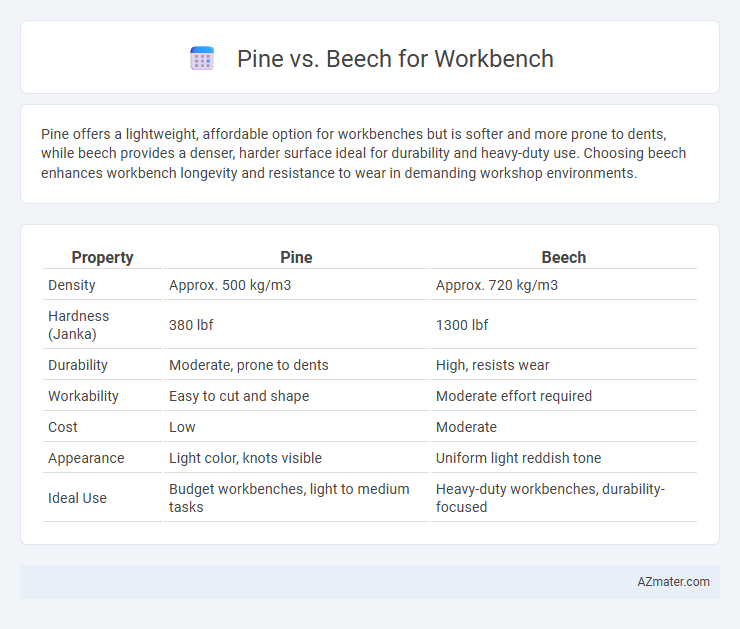Pine offers a lightweight, affordable option for workbenches but is softer and more prone to dents, while beech provides a denser, harder surface ideal for durability and heavy-duty use. Choosing beech enhances workbench longevity and resistance to wear in demanding workshop environments.
Table of Comparison
| Property | Pine | Beech |
|---|---|---|
| Density | Approx. 500 kg/m3 | Approx. 720 kg/m3 |
| Hardness (Janka) | 380 lbf | 1300 lbf |
| Durability | Moderate, prone to dents | High, resists wear |
| Workability | Easy to cut and shape | Moderate effort required |
| Cost | Low | Moderate |
| Appearance | Light color, knots visible | Uniform light reddish tone |
| Ideal Use | Budget workbenches, light to medium tasks | Heavy-duty workbenches, durability-focused |
Introduction: Choosing the Right Wood for Your Workbench
Pine offers a lightweight and affordable option with good workability, ideal for beginners or hobbyists building a workbench. Beech provides a harder, more durable surface with excellent resistance to dents and wear, making it a preferred choice for professional-grade workbenches. Selecting between pine and beech depends on the balance of budget, durability requirements, and the type of workbench usage intended.
Pine vs Beech: Overview of Characteristics
Pine offers a lightweight, softwood option with a pale yellow hue and straight grain, making it easy to shape and ideal for beginners in woodworking. Beech is a dense hardwood known for its fine, tight grain and durability, providing a smooth finish and resistance to wear, which benefits long-term workbench stability. Choosing between pine and beech hinges on balancing softness and workability versus hardness and longevity for your specific workbench needs.
Workbench Durability: How Pine and Beech Compare
Beech wood offers superior durability for workbenches due to its dense hardness and resistance to wear, making it ideal for heavy-duty tasks and long-term use. Pine is softer and more prone to dents and scratches, which may require more frequent maintenance or refinishing in a workbench setting. Choosing beech enhances workbench longevity and stability, ensuring better performance under intensive workloads compared to pine.
Weight and Workability of Pine vs Beech
Pine is significantly lighter than beech, making it easier to handle and move around during workbench construction or use. Beech, known for its dense and hard texture, offers superior durability and resistance to wear, though it is heavier and more challenging to work with compared to pine. For projects requiring frequent relocation or easier shaping, pine provides better workability, while beech is preferred for a sturdier, long-lasting workbench surface.
Cost Analysis: Pine vs Beech for Budget-Friendly Workbenches
Pine wood offers a more budget-friendly option for workbenches due to its lower cost and widespread availability compared to beech. Beech, while more expensive, provides superior durability and resistance to wear, which can reduce long-term maintenance expenses. Choosing pine can significantly lower initial investment, but beech may offer better value over time for heavy-duty workbench applications.
Surface Hardness: Protecting Your Bench from Damage
Beech offers superior surface hardness compared to pine, making it more resistant to dents and scratches that occur during heavy-duty workbench use. Pine's softer texture is prone to damage from tools and heavy impacts, requiring frequent maintenance or protective coatings to preserve the surface. Choosing beech extends the longevity of your workbench surface, providing a durable, reliable workspace ideal for woodworking and heavy materials handling.
Availability and Sourcing: Pine and Beech Options
Pine is widely available and sourced from fast-growing, sustainable plantations, making it a cost-effective choice for workbenches. Beech, while more durable and dense, is less abundant and typically sourced from mature hardwood forests, resulting in higher prices and limited availability. Choosing between pine and beech depends on balancing budget constraints with desired workbench strength and longevity.
Environmental Impact and Sustainability Considerations
Pine workbenches are often sourced from fast-growing softwoods, making them a more renewable choice with a lower carbon footprint compared to beech. Beech, a hardwood, typically requires longer growth periods and more energy-intensive processing, contributing to higher environmental impact. Choosing sustainably harvested pine certified by organizations like FSC ensures reduced deforestation and supports responsible forest management.
Best Uses: When to Choose Pine or Beech for Your Workbench
Pine is ideal for workbenches used in light to moderate tasks due to its affordability, ease of shaping, and availability in larger sizes, making it perfect for hobbyists and DIY projects. Beech is best suited for heavy-duty workbenches requiring durability, hardness, and resistance to wear, commonly favored in professional woodworking or metalworking environments. Choosing pine supports cost-effective and versatile setups, while beech ensures longevity and a stable, sturdy work surface under demanding conditions.
Conclusion: Selecting the Ideal Wood for Your Workbench
Pine offers affordability and lightweight ease for a basic workbench but lacks the durability required for heavy-duty tasks, while beech provides superior hardness, resistance to dents, and excellent stability for long-lasting performance. Choosing beech enhances your workbench's resilience and precision, essential for demanding woodworking projects. For a reliable, robust workspace, beech stands out as the ideal wood material.

Infographic: Pine vs Beech for Workbench
 azmater.com
azmater.com